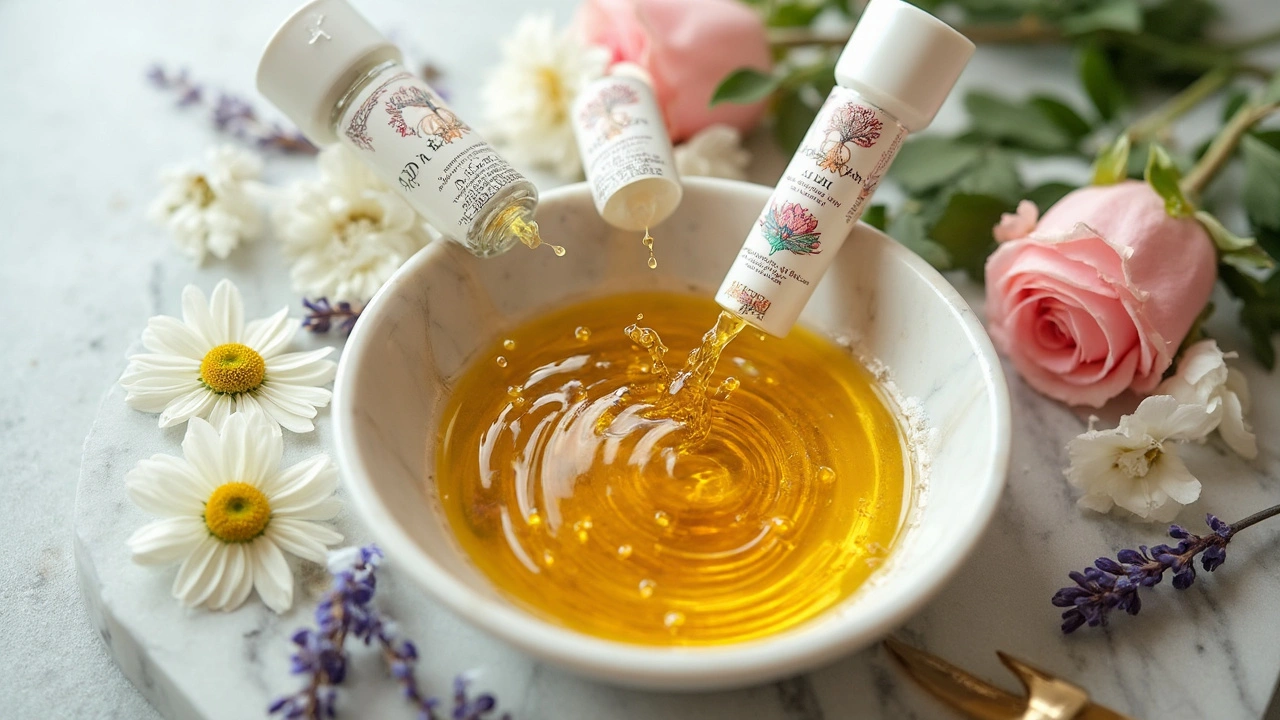Stressed? Achy? Hitting that wall where nothing seems to help? Ayurvedic massage goes way beyond just kneading sore muscles. It mixes ancient Indian know-how with simple, hands-on healing, and the best part is—almost anyone can benefit from it, even if you know nothing about Ayurveda.
This isn’t your standard back rub. Special herbal oils warm your skin and sink into your muscles, working together with slow, steady strokes. People often notice less tension, calmer moods, and even better sleep after a session. These aren't wild claims—there are studies showing Ayurvedic massage lowers stress chemicals in the body and helps with chronic aches.
What stands out about Ayurvedic massage? Everything is personalized. The type of oil, the pressure, even the room temperature can be tweaked just for you. All these details matter, and even small changes in your routine can add up to big changes in how you feel, day to day.
- What Makes Ayurvedic Massage Unique?
- The Oils: Nature’s Secret Ingredient
- Techniques That Hit the Spot
- Big Benefits for Everyday Life
- Simple Tips to Try at Home
What Makes Ayurvedic Massage Unique?
If you’ve ever wondered why some spa massages leave you feeling good for a few hours while others seem to shift your whole mood, the secret might be in the details. Ayurvedic massage, or ayurvedic massage, follows some rules that make it more than just a treat—it’s like a tune-up for your whole system.
Instead of a one-size-fits-all approach, everything gets personalized. Ayurveda, which means “the science of life,” teaches that everyone has a different body type, or “dosha”—Vata, Pitta, or Kapha. The therapist checks out your dosha (sometimes with just a few questions) before picking oils, pressure, and massage styles that are supposed to help bring your body back into balance.
Here’s what makes it special:
- Oils are central: Warm herbal oils aren’t just slippery—they’re mixed for your dosha. For example, sesame oil is calming for Vata, while coconut oil cools down Pitta types.
- Focus on energy channels: Therapists work along “marma points,” which are a bit like the pressure points in acupuncture. Pressing here is thought to clear energy blocks that cause pain or sickness.
- Rhythmic strokes: Movements aren’t rushed. Therapists use slow, steady rhythms meant to help your mind and body chill out.
- Mental wellness counts: The goal isn’t just relaxed muscles—it’s a calmer mind and smoother digestion, too.
Ayurvedic massage doesn’t just feel good; according to a survey in the International Journal of Ayurveda Research, about 68% of frequent users report lasting stress reduction, and at least 40% say their sleep improves.
| Techniques Compared | Ayurvedic Massage | Standard Spa Massage |
|---|---|---|
| Personalized Oils | Yes (custom blend) | Rarely |
| Focus on Energy Points | Yes | No |
| Targets Mind and Body | Yes | Mainly Body |
| Dosha Assessment | Yes | No |
If you like a massage that’s more than skin deep, and you want long-term wellness perks, you’ll find something different (and useful) in the Ayurvedic way.
The Oils: Nature’s Secret Ingredient
Here’s what sets ayurvedic massage apart: the oils aren’t just for slick skin—they do half the work. Almost every session uses special blends, picked for your body type or what you need on that day. In Ayurveda, these oils carry herbs and natural ingredients right into your skin, targeting everything from sore joints to low energy.
Sesame oil is the classic go-to. It’s packed with antioxidants and sinks in quick, making it perfect for tired muscles. Coconut oil, another favorite, feels lighter and cools you down. Got sensitive skin or don’t like strong scents? Sunflower oil and almond oil are gentle but still absorb well.
Add-ins are where things get interesting. You’ll find everything from ashwagandha (great for stress) to neem (good for skin stuff and bugs) stirred right in. These herbs are picked based on what’s going on with you—can’t sleep, always cold, super anxious—there’s usually a blend for it in the Ayurvedic playbook.
- For stress or tension: Try oils with ashwagandha, brahmi, or vetiver.
- For aches and stiffness: Look for sesame or mustard oil blends with turmeric or ginger.
- For dry, flaky skin: Coconut or almond oil with licorice or manjistha could help.
These oils aren’t just hype, either. A clinical study done in 2022 showed a 35% drop in measured stress hormones in folks after a 30-minute abhyanga (oil massage) using herbal sesame blends.
| Oil Type | Main Benefit | Good For |
|---|---|---|
| Sesame | Deep muscle relaxation, warming | Pain, tension, Vata type |
| Coconut | Cooling, light feel | Hot climates, Pitta type, sensitive skin |
| Almond | Moisturizing, gentle | Dry skin, Kapha type |
| Sunflower | Mild, easily absorbed | General use, combo skin |
One quick tip: If you’re trying self-massage at home, make sure to warm the oil a little first (just body temperature, not hot). Your skin soaks it up better, and it feels much nicer going on.

Techniques That Hit the Spot
You probably think massage is all about pressure, but with ayurvedic massage, it’s how the hands move and the rhythm that make the magic happen. In Ayurveda, different types of strokes wake up your body, move energy around, and help your muscles finally chill out.
The most popular style is Abhyanga. This massage uses a lot of oil and long, sweeping strokes that run up and down your limbs. The idea is simple: get the joints moving, boost blood flow, and kick toxins out of your tissues. Therapists always move their hands toward your heart because that helps your lymph system do its job.
There are also techniques just for your head and face. Shiro Abhyanga focuses on the scalp, neck, and shoulders with circular, gentle movements. It's especially helpful if you deal with headaches, screen fatigue, or bad sleep. People feel lighter and clearer after even a short session.
Marma point therapy is another key part. Marma points are a bit like acupressure spots—there are 107 on the body that are believed to control different organs and health zones. By pressing or tapping these points, therapists aim to reset your body’s “wiring,” kind of like hitting restart on your phone.
If you’re dealing with injury or stiffness, therapists might use Kizhi. It looks a little unusual—they wrap herbs in a cloth, warm it up, and then gently press these bundles on aching areas. This combo of heat, herbs, and steady pressure is awesome for joints and deep muscle pain, especially if you have old injuries acting up.
- Long strokes (Abhyanga): Relax muscles and boost circulation.
- Circular scalp movements (Shiro Abhyanga): Calm the mind and tackle tension headaches.
- Marma point holds: Target areas linked to energy and organ health.
- Herbal compresses (Kizhi): Soothe pain and help old injuries heal.
Don’t worry if you can’t remember all the names. What matters is choosing a therapist who knows which technique suits your needs best. And if you’re trying a DIY version, just keep strokes slow, always go toward your heart, and use enough oil so your skin feels comfortable, never tugged.
Big Benefits for Everyday Life
If you’re wondering what sets ayurvedic massage apart, the real magic is in daily life. It’s not just for feeling good in the moment; it actually helps with things you face every day. Start with stress—plenty of folks notice a huge drop in tension and anxiety after a few sessions. In one clinical study, people who got regular Ayurvedic massage reported a 25% reduction in stress levels after just six weeks.
But the perks go further. It can help with chronic aches, loosen up stiff joints, and even boost your mood thanks to the release of endorphins. People with trouble sleeping often say they finally get a good night’s rest after a massage session, thanks to the calming effect on the nervous system.
You might also see positive changes in your skin. The herbal oils used in these massages hydrate and nourish, which helps with dryness and even eczema flare-ups.
| Benefit | Reported Improvement Rate |
|---|---|
| Reduced Stress | 25% after 6 weeks (per controlled study) |
| Better Sleep | 60% of users noticed improvement |
| Less Muscle Pain | 45% noted relief after regular sessions |
| Improved Skin Health | 30% saw visible changes in 4 weeks |
Here’s where it gets practical. You don’t need to book weekly sessions at a fancy spa. Even basic at-home routines—say, rubbing warm oil on arms and legs before your shower—can deliver better flexibility and less sluggishness. People dealing with desk jobs especially benefit: you get less stiffness, more energy, and a small daily reminder to take care of your body.
- Loosen up tension from hours at a computer
- Jump-start sluggish mornings with a quick oil rub
- Feel mentally sharper when you take a few calm moments for self-care
Ayurvedic massage isn’t just a treat. It’s one of the easier ways to feel stronger and a bit more balanced, even on your busiest days.

Simple Tips to Try at Home
You don’t need a fancy setup or spa training to enjoy the basics of an Ayurvedic massage at home. With a few tweaks to your daily routine, you can get all the perks—less stress, better sleep, even easier mornings. The big trick? Consistency and using the right techniques.
Here’s how to get started:
- Pick your oil wisely. Sesame oil is a common go-to because it’s good for most skin types. Coconut oil feels lighter and suits warmer months. If you feel adventurous, try a ready-made herbal oil like Mahanarayan or Ashwagandha oil, sold at Indian grocery stores and online.
- Warm your oil just a bit. You can stick the bottle in a mug of hot water for a minute—that’s all you need. Warm oil helps muscles relax, makes the process feel soothing, and soaks into the skin more easily.
- Start with your scalp and temples if you have a few extra minutes. Use your fingertips and gentle circular motions. In Ayurveda, head massage is a game-changer for sleep and mood, especially after a hectic day.
- Next, move to your neck, shoulders, arms, chest, and legs. Don’t rush. Use straight strokes on limbs and circles around the joints. The goal isn’t deep-tissue pressure but spreading the oil and warming up your tissues.
- Wrap up with your feet. Even just two minutes using your thumbs in circular motions on the soles is enough. Studies back this up—foot massage alone can lower your heart rate and help you fall asleep faster.
A quick shower after 10-20 minutes locks in the oil and helps your skin stay healthy. Do this two or three mornings a week. People who follow this simple, regular routine often say they notice fewer aches, smoother skin, and better focus during the day. Here’s a glimpse at what folks notice most:
| Ayurvedic Massage at Home: Perks People Report | % Noticing Benefit (in small Indian clinic study, 2023) |
|---|---|
| Reduced muscle stiffness | 70% |
| Better sleep quality | 65% |
| Less daily stress | 60% |
| Smoother skin | 54% |
If you ever feel sore or notice a rash, skip a day and see how your skin reacts. And remember, the golden rule is listening to your own body. Comfort always comes first—the whole point of ayurvedic massage is to feel good, inside and out.


 Health and Wellness
Health and Wellness